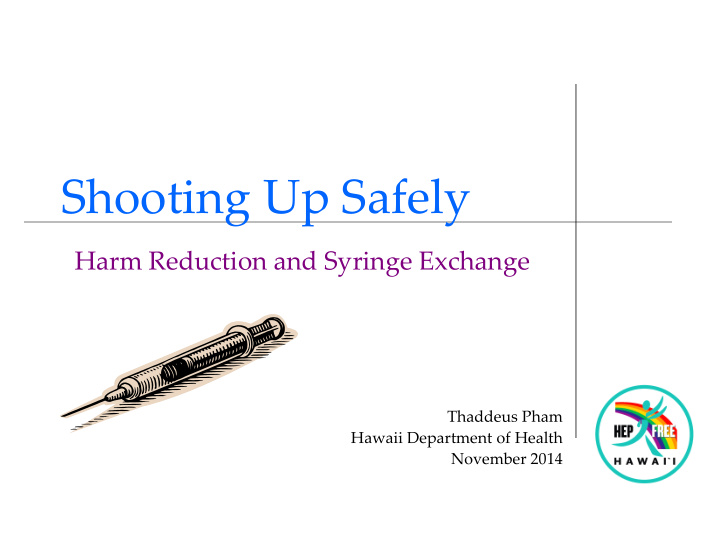



Shooting Up Safely D Harm Reduction and Syringe Exchange D D D D d Thaddeus Pham Hawaii Department of Health November 2014
Meet your liver!
What can hepatitis lead to? Usually no symptoms for 20-30 years Without treatment, hepatitis can lead to liver cancer
C Is for…Cooker! Transmission routes direct BLOOD-to-BLOOD mostly, sharing needles/works other possible risks? Highly infectious stable in environment for 4 days to 6 weeks stable in syringes for up to 63 days! NO VACCINE!
Beyond C is for Cooker... Sharing Injection Equipment Not only NEEDLES cookers cottons water other paraphernalia Not only DRUG USERS transgender (hormones) bodybuilders (steroids, vitamins) diabetics (insulin) Bleach may kill HCV but only if properly used 5
What is happening? Hawai`i = highest rate of liver cancer in US The leading causes of liver cancer in HI hepatitis B hepatitis C
Harm Reduction… Harm reduction is a philosophy and set of strategies for working with individuals engaged in potentially harmful behaviors. The main objective is to reduce the potential dangers and health risks associated with such behaviors, even for those who are not willing or able to completely stop. Harm reduction uses a non-judgmental, holistic and individualized approach to support incremental change and increase the health and well-being of individuals and communities.
Reducing the Harm Harm reduction is a philosophy and set of strategies for working with individuals engaged in potentially harmful behaviors. The main objective is to reduce the potential dangers and health risks associated with such behaviors, even for those who are not willing or able to completely stop. Harm reduction uses a non-judgmental, holistic and individualized approach to support incremental change and increase the health and well-being of individuals and communities.
History of Harm Reduction Merseyside, England (1980s) Response to HIV, Hepatitis B Syringe exchange Netherlands (1980s) Public health, law enforcement, community United States (1988) 1 st syringe exchange Hawaii (1989) 1 st Statewide syringe exchange
What is Syringe Exchange? Reduce Bloodborne Risks Collect used syringes Replace with sterile ones Drug User Health HIV/Hep Testing Drug treatment Other services! Healthier communities Protect families of drug users Less syringes in communities In 2011, at least 211 SEPs in U.S.
Hawaii and Harm Reduction Street Outreach (1980s) Bleach for needles Pilot SEP (1989) Gov Committee on AIDS Pam Lichty, Nancy Kern, Nancy Partika RCUH Research (1990) Act 152 (1993) DOH to oversee SEP CHOW only recipient CHOW 501c3 (1999) Hep Free Hawaii (2011)
[325-111] Sterile Needle and Syringe Exchange Established Establishes SEP through Department of Health (may be contracted out) Requires one-for-one exchange Extensive data collection and annual evaluation to demonstrate effectiveness Syringe Exchange Oversight Committee Comprised of law enforcement, policy makers, Attorney General’s office, DOH
[325-111] Criminal Liability “Exchanges under the sterile needle and syringe exchange program shall not constitute an offense under section 329-43.5 for the participant or for the employees of the department or its designees”
[325-21] Sale of Sterile Syringes for the Prevention of Disease Allows the sale of sterile syringes by: Pharmacist Physician Healthcare provider Authorized agent of pharmacy Must provide education about diseases, drug treatment and disposal “Sale or purchase of sterile hypodermic syringes under subsection (a) shall not constitute an offense under section 329-43.5”
Syringes Exchanged 1993-2012 800,000 700,000 7.7 million 600,000 syringes 500,000 exchanged 400,000 300,000 200,000 100,000 - 1993 1994 1995 1996 1997 1998 1999 2000 2001 2002 2003 2004 2005 2006 2007 2008 2009 2010 2011 2012
Evidence of Effectiveness World Health Organization Hawaii Data Over 200 studies AIDS among PWID: 14.7% HI vs. 32.3% nationally Reduce HIV Low HIV rates among women Reduce used syringes and children No increase in drug use CHOW Project: <3% HIV No new HIV+ for 6 years
Harm Reduction in Hawaii The Community Health Outreach Work (CHOW) Project is dedicated to serving individuals, families and communities adversely affected by drug use, especially people who inject drugs, through a participant-centered harm reduction approach. CHOW works to reduce drug-related harms such as but not limited to HIV, hepatitis B/C and overdose. CHOW supports the optimal health and well-being of people affected by drug use throughout the State of Hawaii.
What does CHOW do? Statewide Syringe Exchange Mobile vans Individuals HIV/Hep Testing Care Coordination Hygiene kits, supplies Referrals Drug treatment Mental Health
What does CHOW do? Outreach Drug Users Homeless Sex Workers Housing Linkage Advocacy Good Samaritan River Street and Vineyard Overdose Prevention 9 am – 2 pm (M – F)
CHOW Is a Community Young Injection Drug Users Massachussets (MMWR 2011) Age distribution of newly reported HCV 2002-2009 Hawaii (CHOW report 2013) HCV antibody positive rate 18.4 (2011) to 28.6% (2012) 21
Syringe Exchange in Hawaii Evidence-based Increase HIV and hepatitis prevention Decrease “dirty” needles in circulation No increase in drug use Increase community health Keep families healthy Overdose prevention Housing and social services
Former CHOW Participant Now in Recovery “CHOW saved my life. When I was out there, I lost everything and everyone. CHOW’s outreach workers respected me when I couldn’t respect myself. They helped me stay alive until I was ready to help myself. ”
How can I help? www.hepfreehawaii.org www.chowproject.org
Mahalo! Reach out! Thaddeus Pham thaddeus.pham@doh.hawaii.gov
Recommend
More recommend